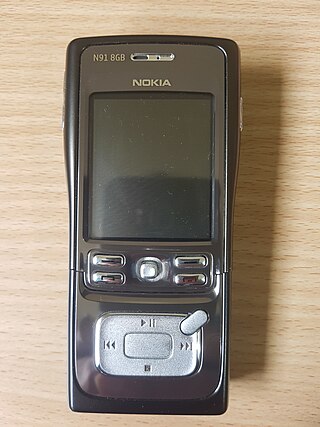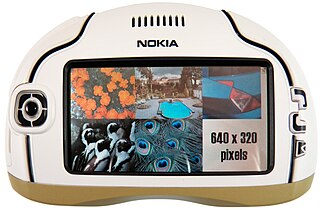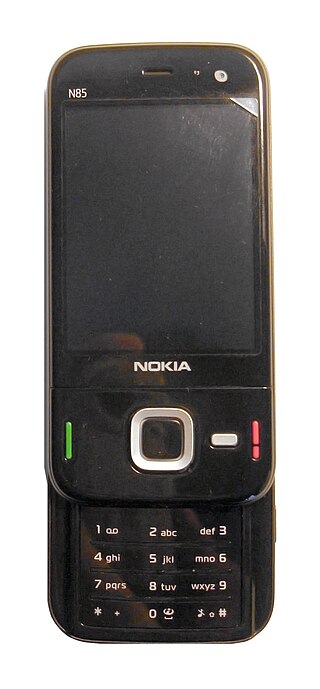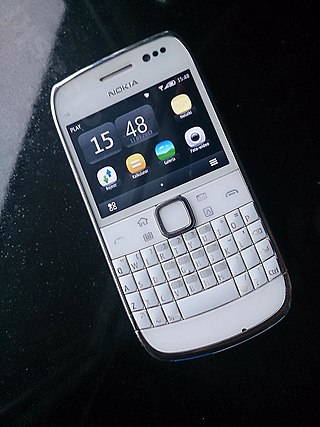Related Research Articles

The S60 Platform was a software platform for smartphones that runs on top of the Symbian operating system. It was created by Nokia based on the 'Pearl' user interface from Symbian Ltd. It was introduced at COMDEX in November 2001 and first shipped with the Nokia 7650 smartphone. The platform has since seen 5 updated editions. Series 60 was renamed to S60 in November 2005.
DVB-H is one of three prevalent mobile TV formats. It is a technical specification for bringing broadcast services to mobile handsets. DVB-H was formally adopted as ETSI standard EN 302 304 in November 2004. The DVB-H specification can be downloaded from the official DVB-H website. From March 2008, DVB-H is officially endorsed by the European Union as the "preferred technology for terrestrial mobile broadcasting". The major competitors of this technology are Qualcomm's MediaFLO system, the 3G cellular system based MBMS mobile-TV standard, and the ATSC-M/H format in the U.S. DVB-SH now and DVB-NGH in the future are possible enhancements to DVB-H, providing improved spectral efficiency and better modulation flexibility. DVB-H has been a commercial failure, and the service is no longer on-air. Ukraine was the last country with a nationwide broadcast in DVB-H, which began transitioning to DVB-T2 during 2019.

The Nokia N91 is a smartphone produced by Nokia as part of their Nseries line of portable devices. It was announced on April 27, 2005 along with N70 and N90 as the first three Nseries devices. The N91 ran on Symbian-based S60 3rd Edition. It was the first ever phone encompassing a 4 GB internal hard drive, allowing storage for 3,000 songs. The N91 is highly focused on music,. with dedicated music keys on the front which slide down to reveal the keypad. It also featured the industry-standard 3.5 mm headphone jack, and was anticipated as a major challenger to Apple, whose iPod dominated the industry. The design of the N91 is based on stainless steel with a matte finish.
Nokia Browser for Symbian was the default web browser for the S60 and Symbian mobile phone platform. The browser is based on a port of Apple Inc.'s open-source WebCore and JavaScriptCore frameworks which form the WebKit rendering engine that Apple uses in its Safari Web browser.

The Nokia 7710 is a smartphone developed by Nokia and announced on 2 November 2004. It was the first Nokia device with a touchscreen, and first Nokia branded device with 2:1 aspect ratio display. The 7710 is based on the Nokia 7700 which was never released. It is Nokia's only smartphone to run the Series 90 interface atop Symbian OS v7.0s.

The Nokia N92 is a smartphone part of the multimedia Nseries. It was announced on November 2, 2005 and was the world's first mobile phone with an integrated DVB-H tuner. As a result, Nokia marketed it as a phone for watching TV on the go. It featured the same swivel design as the N90. It runs on Symbian OS v9.1 and the S60 3rd Edition interface.

The Nokia N71 is a mobile phone announced by Nokia on 2 November 2005 and released in June 2006. It was Nokia's joint-first clamshell smartphone, like the N92 announced on the same day. The N71 runs on Symbian OS v9.1.

The Nokia N73 is a mobile phone announced by Nokia on 2006 as part of the Nseries and started shipping on 15 July. The N73 succeeded the N70 and packed in numerous multimedia features. It features a 3.2 megapixel autofocus camera, a front camera, a then-large 2.4-inch display, and stereo speakers, all in a relatively slim and pocketable size and form. It runs on Symbian v9.1. An improved, music-focused version called N73 Music Edition was released in 2007.

The Nokia 7700 is a smartphone produced by Nokia, announced in October 2003 but never released. It was produced as a prototype unit between 2003-2004. It was expected to be the first smartphone running the Series 90 GUI on Symbian OS and Nokia's first pen-based device, intending to compete against handsets like Sony Ericsson P800. At announcement Nokia dubbed it a "media device."

The Nokia N97 is a high-end smartphone introduced on 2 December 2008 by telecommunications manufacturer Nokia as part of its Nseries and released in June 2009 as the successor to the Nokia N96 phone. The N97 was Nokia's second S60-based touchscreen phone, after the Nokia 5800 XpressMusic. The device featured slide-out QWERTY keyboard, and ran on the Symbian v9.4 operating system. Its design took cues from the Nokia N79. A smaller and lower-cost variant, the Nokia N97 mini, was later released.

The Nokia N85 is a mobile phone produced by Nokia, announced on 27 August 2008 as part of the Nseries line. The N85 runs on Symbian OS v9.3 with S60 3rd Edition platform with Feature Pack 2. It was released in October, retailing for 450 euros before taxes.

The Nokia N86 8MP is a high-end mobile phone with emphasis on the camera. It was announced on 17 February 2009 and released in May 2009 as part of the Nseries. It runs on Symbian OS 9.3 and shares similar design features with the N97. Its name references the camera's megapixel count.
Nokia SU-33W is a Nokia's Mobile TV Receiver. With this optional DVB-H it is possible to watch television on the screen of the phone. Many Nokia mobile phones with Bluetooth are compatible.
Nokia 5330 Mobile TV Edition is a mobile phone from Nokia, announced on 16 November 2009. It features a DVB-H television receiver, and has been Nokia's only non-smartphone to do so. Its design is based on that of the Nokia 5330 XpressMusic, announced earlier in 2009.

Symbian is a discontinued mobile operating system (OS) and computing platform designed for smartphones. It was originally developed as a proprietary software OS for personal digital assistants in 1998 by the Symbian Ltd. consortium. Symbian OS is a descendant of Psion's EPOC, and was released exclusively on ARM processors, although an unreleased x86 port existed. Symbian was used by many major mobile phone brands, like Samsung, Motorola, Sony Ericsson, and above all by Nokia. It was also prevalent in Japan by brands including Fujitsu, Sharp and Mitsubishi. As a pioneer that established the smartphone industry, it was the most popular smartphone OS on a worldwide average until the end of 2010, at a time when smartphones were in limited use, when it was overtaken by iOS and Android. It was notably less popular in North America.

The Nokia N8 is a touchscreen-based smartphone developed by Nokia. Announced on 27 April 2010, the Nokia N8 was the first device to run on the Symbian^3 mobile operating system and it was the company's flagship device for the year. It was released on 30 September 2010 at the Nokia Online Store before being released in markets around the world on 1 October 2010. There were two version made, the N8 and the N8-00. The N8 was made for Vodafone and locked to its networks, and the N8-00 was made by Microsoft and open network.

The Nokia Nseries was a high-end lineup of feature phones, smartphones, and tablets marketed by Nokia Corporation from 2005 to 2011. The Nseries devices commonly supported multiple high-speed wireless technologies at the time, such as 3G, or Wireless LAN. Digital multimedia services, such as music playback, photo/video capture or viewing, gaming or internet services were the central focus of the lineup. The lineup was replaced in 2011 by the Nokia Lumia line as the company's primary smartphone lineup.

The Nokia 3650, sold in North American markets as the Nokia 3600, is a mobile phone from Nokia announced on 6 September 2002 as the successor to the Nokia 7650. It runs Symbian OS Series 60.

The Nokia E6-00 is a smartphone running the Symbian^3 operating system. It supersedes the Nokia E72 as the new Symbian business mobility solution from Nokia following its announcement on 12 April 2011. It shipped with the new "Symbian Anna" version of Symbian^3, and originally retailed for 340 euros before taxes.
Nokia's strategic nomenclature can be traced back in 2005 when the Nseries line was launched, offering devices with flagship specifications and premium hardware at various price points. These devices were considered the "bread and butter" of the company and were often positioned to showcase their latest technologies. Thanks to the newfound consumer and enterprise interest in smartphones at the time, the company introduced four additional collections to diversify their product portfolio and meet demands in most market segments. These new phone series were named Eseries, targeting small business and enterprise customers; Xseries, providing consumer-grade multimedia-focused devices; Cseries, which Nokia used to target both the low-end and mid-range market segments; and Tseries, for devices exclusive to the Chinese market.
References
- ↑ "Nokia N77 - Full phone specifications". www.gsmarena.com.
- ↑ "Nokia announces the E65, E61i, N77, 6110, and E90 at 3GSM". ZDNet .
- ↑ "Nokia N77: Live TV when you want it". Nokia. 12 February 2007. Archived from the original on 26 July 2014. Retrieved 13 November 2022.
- ↑ "Nokia N77 Preview - DVB-H Mobile TV Handset". All About Symbian. 18 March 2007.